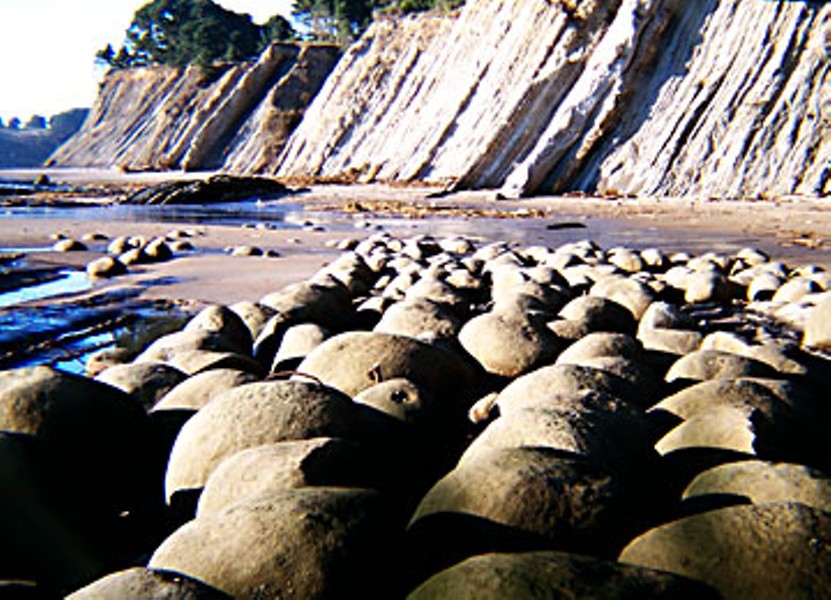Meter-sized spherical rocks decorate Bowling Ball Beach three miles south of Point Arena in Mendocino County. They have gathered there into rows on a corrugated wave-cut platform eroded into inclined sedimentary sandstones. These hard spheres are not boulders abraded by rivers or surf, but are erosion-resistant calcite-cemented spheres eroded directly from those inclined softer sandstones. Such calcite-cemented concretions can also be seen in road cuts in semi-consolidated sandstones south of Ferndale and elsewhere.
The diagrams show how a concretion forms by localized cementation of sand grains. The usual conditions required to form a concretion are pore waters over-saturated with respect to calcite, CaCO3, and the presence of a seed of calcite, perhaps a shell fragment, on which more calcite can grow. Let's begin with sand deposited below sea level. Shallow ocean water is saturated with respect to calcite, but it often requires a mollusk, urchin or coral to induce calcite to precipitate, unless the sea water experiences evaporation. One process that can cause marine pore water to precipitate calcite is the reduction of dissolved or solid calcium sulfate by organic material or methane: CaSO4 + CH4 = CaCO3 + H2S + H2O. This explains why a concretion may encase a fossil even if the organism had no shell. Visit our Museum of Natural History to see fine fossils preserved in concretions.
Visit Mars to see abundant small concretions of hematite, Fe2O3, nick-named "blueberries," very similar to iron oxide concretions weathering out of Utah's Navajo Sandstone.
Reader Comments regarding "Lagoons and Beaches", July 3:
Dan O'Shea of College of the Redwoods provided an explanation for the deposition of sand on beaches by summer, but not winter, waves: Small waves percolate into the beach, stranding their load of sand, whereas large waves carry too much water to soak in. I should have figured that out myself because I was aware that one method of promoting the growth of a beach is to pump out its pore water via buried perforated pipes.
Bay Commissioner Mike Wilson pointed out that although tidal flows maintained a shallow opening to Humboldt Bay in prehistoric times, the present deep entrance is the consequence of two jetties plus the annual dredging of 1.5 million cubic yards of sand.



Comments